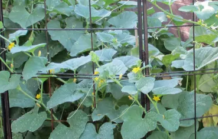Slime molds are primitive organisms that are common on turf and mulch. Slime molds are not fungi and are no longer classified as such.
They belong to the Kingdom Protista rather than Kingdom Fungi. On turf, you might often see large numbers of small gray, white or purple fruiting structures, called sporangia on leaf blades during cool and humid weather throughout spring, summer, and fall. Affected areas are often several inches to 1 foot in diameter. During wet weather, the fruiting structures may appear slimy. As the structures dry out in hot weather, they become ash gray and break up easily when touched.
Homeowners often are concerned that this is a disease organism that will kill the grass, but slime mold feeds on bacteria, other fungi, and dead organic matter. It simply uses the turf as a structure on which to grow. However, slime mold can damage turf by completely covering leaf blades and interfering with photosynthesis. Chemical control of slime molds is not necessary. Use a broom or a heavy spray of water to dislodge the mold.
Slime molds on mulch often attract attention because of their bright colors and disgusting appearance. Common names are often quite descriptive. For example, the “dog vomit” slime mold is a bright, whitish color that resembles its namesake. It eventually turns brown and then into a hard, white mass. There is also the “scrambled egg” slime mold, “the yellow blob” slime mold and the “regurgitated cat breakfast”
slime mold. Slime molds do not hurt anything, but most people do not find them attractive and want to get rid of them. Simply use a shovel to discard the offensive organism and then stir up the mulch for aeration.
(Ward Upham)




